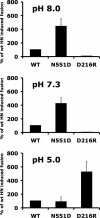Fusion promotion by a paramyxovirus hemagglutinin-neuraminidase protein: pH modulation of receptor avidity of binding sites I and II
- PMID: 17567695
- PMCID: PMC1951465
- DOI: 10.1128/JVI.00888-07
Fusion promotion by a paramyxovirus hemagglutinin-neuraminidase protein: pH modulation of receptor avidity of binding sites I and II
Abstract
Paramyxoviruses, including the childhood respiratory pathogen human parainfluenza virus type 3 (HPIV3), possess an envelope protein hemagglutinin-neuraminidase (HN) that has receptor-cleaving (neuraminidase), as well as receptor-binding, activity. HN is a type II transmembrane glycoprotein, present on the surface of the virus as a tetramer composed of two dimers. HN is also essential for activating the fusion protein (F) to mediate merger of the viral envelope with the host cell membrane. This initial step of viral entry occurs at the host cell surface at neutral pH. The HN molecule carries out these three different critical activities at specific points in the process of viral entry, and understanding the regulation of these activities is key for the design of strategies that block infection. One bifunctional site (site I) on the HN of HPIV3 possesses both receptor binding and neuraminidase activities, and we recently obtained experimental evidence for a second receptor binding site (site II) on HPIV3 HN. Mutation of HN at specific residues at this site, which is next to the HN dimer interface, confers enhanced fusion properties, without affecting neuraminidase activity or receptor binding at neutral pH. We now demonstrate that mutations at this site II, as well as at site I, confer pH dependence on HN's receptor avidity. These mutations permit pH to modulate the binding and fusion processes of the virus, potentially providing regulation at specific stages of the viral life cycle.
Figures








References
-
- Crennell, S., T. Takimoto, A. Portner, and G. Taylor. 2000. Crystal structure of the multifunctional paramyxovirus hemagglutinin-neuraminidase. Nat. Struct. Biol. 7:1068-1074. - PubMed
-
- Deng, R., Z. Wang, P. J. Mahon, M. Marinello, A. Mirza, and R. M. Iorio. 1999. Mutations in the Newcastle disease virus hemagglutinin-neuraminidase protein that interfere with its ability to interact with the homologous F protein in the promotion of fusion. Virology 253:43-54. - PubMed
-
- Deng, R., Z. Wang, A. Mirza, and R. Iorio. 1995. Localization of a domain on the paramyxovirus attachment protein required for the promotion of cellular fusion by its homologous fusion protein spike. Virology 209:457-469. - PubMed
Publication types
MeSH terms
Substances
Grants and funding
LinkOut - more resources
Full Text Sources

